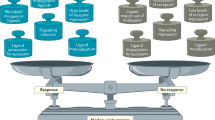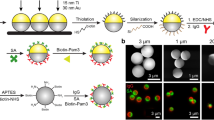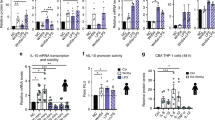Key Points
-
Recent work examining the cell biology of Toll-like receptors (TLRs) illustrates how basic aspects of the cellular machinery contribute to receptor function and regulation.
-
Despite residing on several organelles, all TLRs are first transported to the Golgi complex before being routed to the appropriate location. Bacterium-sensing TLRs probably follow the default secretory pathway from the Golgi to the cell surface, whereas TLRs that detect viral nucleic acids are delivered to endolysosomes by the chaperone Unc93B1.
-
Compartment-specific activity of nucleic acid-sensing TLRs (for example, TLR7 and TLR9) is maintained by compartment-specific cleavage events that generate functional receptors. These cleavage events are probably mediated by lysosomal cathepsins, and consequently nucleic acid-sensing TLRs are only active in endolysosomes.
-
Bacterium-sensing TLRs (such as TLR2 and TLR4) use sorting adaptor proteins to determine the subcellular sites of signal transduction. For TLR4, the sorting adaptors TIRAP (TIR domain-containing adaptor protein) and TRAM (TRIF-related adaptor molecule) function to recruit their downstream signalling machinery to the plasma membrane and endosomes, respectively.
-
Sorting adaptor proteins are positioned in specific intracellular subcompartments by interacting with phosphoinositides. Regulators of phosphoinositide metabolism may therefore control the activity of specific TLR signalling pathways.
-
Endolysosomes seem to be the sole subcompartments that allow a TLR-dependent interferon response. Consequently, the plasma membrane-localized TLR4 must first be internalized into endosomes before the interferon-inducing signalling pathway can be activated.
Abstract
An emerging paradigm in innate immune signalling is that cell biological context can influence the outcome of a ligand–receptor interaction. In this Review we discuss how Toll-like receptor (TLR) activation and signal transduction are regulated by subcellular compartmentalization of receptors and downstream signalling components. In particular, we focus on the functional specialization of TLRs in the endosomal system. We discuss recent studies that illustrate how basic aspects of the cellular machinery contribute to TLR function and regulation. This emerging area of research will provide important information on how immune signal transduction networks depend on (and in some cases influence) the generic regulators that organize eukaryotic cells.
This is a preview of subscription content, access via your institution
Access options
Subscribe to this journal
Receive 12 print issues and online access
$209.00 per year
only $17.42 per issue
Buy this article
- Purchase on Springer Link
- Instant access to full article PDF
Prices may be subject to local taxes which are calculated during checkout


Similar content being viewed by others
References
Medzhitov, R. Recognition of microorganisms and activation of the immune response. Nature 449, 819–826 (2007).
Takeda, K., Kaisho, T. & Akira, S. Toll-like receptors. Annu. Rev. Immunol. 21, 335–376 (2003).
Janeway, C. A. Jr. Approaching the asymptote? Evolution and revolution in immunology. Cold Spring Harb. Symp. Quant. Biol. 54, 1–13 (1989).
Medzhitov, R. & Janeway, C. A. Jr. Innate immunity: the virtues of a nonclonal system of recognition. Cell 91, 295–298 (1997).
Jin, M. S. et al. Crystal structure of the TLR1–TLR2 heterodimer induced by binding of a tri-acylated lipopeptide. Cell 130, 1071–1082 (2007).
Kim, H. M. et al. Crystal structure of the TLR4–MD-2 complex with bound endotoxin antagonist eritoran. Cell 130, 906–917 (2007).
Liu, L. et al. Structural basis of Toll-Like receptor 3 signaling with double-stranded RNA. Science 320, 379–381 (2008).
Iwasaki, A. & Medzhitov, R. Toll-like receptor control of the adaptive immune responses. Nature Immunol. 5, 987–995 (2004).
Kawai, T. & Akira, S. TLR signaling. Cell Death Differ. 13, 816–825 (2006).
Akashi, S. et al. Lipopolysaccharide interaction with cell surface Toll-like receptor 4–MD-2: higher affinity than that with MD-2 or CD14. J. Exp. Med. 198, 1035–1042 (2003).
Husebye, H. et al. Endocytic pathways regulate Toll-like receptor 4 signaling and link innate and adaptive immunity. Embo J. 25, 683–692 (2006).
Underhill, D. M. et al. The Toll-like receptor 2 is recruited to macrophage phagosomes and discriminates between pathogens. Nature 401, 811–815 (1999).
Marshak-Rothstein, A. Toll-like receptors in systemic autoimmune disease. Nature Rev. Immunol. 6, 823–835 (2006).
Barton, G. M. Viral recognition by Toll-like receptors. Semin. Immunol. 19, 33–40 (2007).
Boule, M. W. et al. Toll-like receptor 9-dependent and -independent dendritic cell activation by chromatin–immunoglobulin G complexes. J. Exp. Med. 199, 1631–1640 (2004).
Lau, C. M. et al. RNA-associated autoantigens activate B cells by combined B cell antigen receptor/Toll-like receptor 7 engagement. J. Exp. Med. 202, 1171–1177 (2005).
Leadbetter, E. A. et al. Chromatin–IgG complexes activate B cells by dual engagement of IgM and Toll-like receptors. Nature 416, 603–607 (2002).
Berland, R. et al. Toll-like receptor 7-dependent loss of B cell tolerance in pathogenic autoantibody knockin mice. Immunity 25, 429–440 (2006).
Christensen, S. R. et al. Toll-like receptor 9 controls anti-DNA autoantibody production in murine lupus. J. Exp. Med. 202, 321–331 (2005).
Christensen, S. R. et al. Toll-like receptor 7 and TLR9 dictate autoantibody specificity and have opposing inflammatory and regulatory roles in a murine model of lupus. Immunity 25, 417–428 (2006).
Lande, R. et al. Plasmacytoid dendritic cells sense self-DNA coupled with antimicrobial peptide. Nature 449, 564–569 (2007).
Pisitkun, P. et al. Autoreactive B cell responses to RNA-related antigens due to TLR7 gene duplication. Science 312, 1669–1672 (2006).
Subramanian, S. et al. A Tlr7 translocation accelerates systemic autoimmunity in murine lupus. Proc. Natl Acad. Sci. USA 103, 9970–9975 (2006).
Hacker, H. et al. CpG-DNA-specific activation of antigen-presenting cells requires stress kinase activity and is preceded by non-specific endocytosis and endosomal maturation. Embo J. 17, 6230–6240 (1998). This paper is the first to describe the requirement for internalization of TLR9 ligands.
Ewaschuk, J. B. et al. Surface expression of Toll-like receptor 9 is upregulated on intestinal epithelial cells in response to pathogenic bacterial DNA. Infect. Immun. 75, 2572–2579 (2007).
Honda, K. et al. Spatiotemporal regulation of MyD88–IRF-7 signalling for robust type-I interferon induction. Nature 434, 1035–1040 (2005).
Latz, E. et al. TLR9 signals after translocating from the ER to CpG DNA in the lysosome. Nature Immunol. 5, 190–198 (2004). This paper is the first to suggest that TLR9 is an ER-resident protein with unique trafficking properties.
Leifer, C. A. et al. TLR9 is localized in the endoplasmic reticulum prior to stimulation. J. Immunol. 173, 1179–1183 (2004).
Matsumoto, M. et al. Subcellular localization of Toll-like receptor 3 in human dendritic cells. J. Immunol. 171, 3154–3162 (2003).
Barton, G. M., Kagan, J. C. & Medzhitov, R. Intracellular localization of Toll-like receptor 9 prevents recognition of self DNA but facilitates access to viral DNA. Nature Immunol. 7, 49–56 (2006).
Kim, Y. M., Brinkmann, M. M., Paquet, M. E. & Ploegh, H. L. UNC93B1 delivers nucleotide-sensing toll-like receptors to endolysosomes. Nature 452, 234–238 (2008). This paper implicates UNC93B1 in the trafficking of TLR9 from the ER to endolysosomes.
Ewald, S. E. et al. The ectodomain of Toll-like receptor 9 is cleaved to generate a functional receptor. Nature 456, 658–662 (2008).
Park, B. et al. Proteolytic cleavage in an endolysosomal compartment is required for activation of Toll-like receptor 9. Nature Immunol. 9, 1407–1414 (2008). References 32 and 33 report that TLR9 is cleaved in its extracellular domain prior to activation.
Brinkmann, M. M. et al. The interaction between the ER membrane protein UNC93B and TLR3, 7, and 9 is crucial for TLR signaling. J. Cell Biol. 177, 265–275 (2007).
Tabeta, K. et al. The Unc93b1 mutation 3d disrupts exogenous antigen presentation and signaling via Toll-like receptors 3, 7 and 9. Nature Immunol. 7, 156–164 (2006). This paper shows that UNC93B1 is necessary for function of the intracellular TLRs.
Asagiri, M. et al. Cathepsin K-dependent Toll-like receptor 9 signaling revealed in experimental arthritis. Science 319, 624–627 (2008). This paper reports a role for cathepsin K in TLR9 signalling.
Matsumoto, F. et al. Cathepsins are required for Toll-like receptor 9 responses. Biochem. Biophys. Res. Commun. 367, 693–699 (2008). This paper provides the first evidence that cathepsins are involved in TLR9 activation.
Latz, E. et al. Ligand-induced conformational changes allosterically activate Toll-like receptor 9. Nature Immunol. 8, 772–779 (2007).
Bell, J. K., Askins, J., Hall, P. R., Davies, D. R. & Segal, D. M. The dsRNA binding site of human Toll-like receptor 3. Proc. Natl Acad. Sci. USA 103, 8792–8797 (2006).
Kawai, T. & Akira, S. Innate immune recognition of viral infection. Nature Immunol. 7, 131–137 (2006).
Fitzgerald, K. A. et al. Mal (MyD88-adapter-like) is required for Toll-like receptor-4 signal transduction. Nature 413, 78–83 (2001).
Fitzgerald, K. A. et al. LPS–TLR4 signaling to IRF-3/7 and NF-κB involves the Toll adapters TRAM and TRIF. J. Exp. Med. 198, 1043–1055 (2003).
Horng, T., Barton, G. M. & Medzhitov, R. TIRAP: an adapter molecule in the Toll signaling pathway. Nature Immunol. 2, 835–841 (2001).
Medzhitov, R. et al. MyD88 is an adaptor protein in the hToll/IL-1 receptor family signaling pathways. Mol. Cell 2, 253–258 (1998).
Oshiumi, H., Matsumoto, M., Funami, K., Akazawa, T. & Seya, T. TICAM-1, an adaptor molecule that participates in Toll-like receptor 3-mediated interferon-β induction. Nature Immunol. 4, 161–167 (2003).
Yamamoto, M. et al. Role of adaptor TRIF in the MyD88-independent toll-like receptor signaling pathway. Science 301, 640–643 (2003).
Yamamoto, M. et al. TRAM is specifically involved in the Toll-like receptor 4-mediated MyD88-independent signaling pathway. Nature Immunol. 4, 1144–1150 (2003).
Yamamoto, M. et al. Cutting edge: a novel Toll/IL-1 receptor domain-containing adapter that preferentially activates the IFN-β promoter in the Toll-like receptor signaling. J. Immunol. 169, 6668–6672 (2002).
Horng, T., Barton, G. M., Flavell, R. A. & Medzhitov, R. The adaptor molecule TIRAP provides signalling specificity for Toll-like receptors. Nature 420, 329–333 (2002).
Yamamoto, M. et al. Essential role for TIRAP in activation of the signalling cascade shared by TLR2 and TLR4. Nature 420, 324–329 (2002).
Hemmi, H., Kaisho, T., Takeda, K. & Akira, S. The roles of Toll-like receptor 9, MyD88, and DNA-dependent protein kinase catalytic subunit in the effects of two distinct CpG DNAs on dendritic cell subsets. J. Immunol. 170, 3059–3064 (2003).
Kawai, T. et al. Interferon-α induction through Toll-like receptors involves a direct interaction of IRF7 with MyD88 and TRAF6. Nature Immunol. 5, 1061–1068 (2004).
Kagan, J. & Medzhitov, R. Phosphoinositide-mediated adaptor recruitment controls Toll-like receptor signaling. Cell 125, 943–955 (2006). This paper provides the first evidence that TLR adaptors can interact with phosphoinositides, and the authors put forward the sorting adaptor hypothesis to distinguish the functions of TIRAP and MYD88 in TLR signalling.
Kagan, J. et al. TRAM couples endocytosis of Toll-like receptor 4 to the induction of interferon-β. Nature Immunol. 9, 361–368 (2008). This paper provides the first evidence that TLR4 induces its two signalling pathways sequentially, by a process coordinated around the endocytosis of the receptor.
Peter, U., Frank, P., Rudi, B. & Jan, T. MAPPIT analysis of TLR adaptor complexes. FEBS Lett. 581, 629–636 (2007).
Oshiumi, H. et al. TIR-containing adapter molecule (TICAM)-2, a bridging adapter recruiting to Toll-like receptor 4 TICAM-1 that induces interferon-β. J. Biol. Chem. 278, 49751–49762 (2003).
Rowe, D. C. et al. The myristoylation of TRIF-related adaptor molecule is essential for Toll-like receptor 4 signal transduction. Proc. Natl Acad. Sci. USA 103, 6299–6304 (2006).
Palsson-McDermott, E. M. et al. TAG, a splice variant of the adaptor TRAM, negatively regulates the adaptor MyD88-independent TLR4 pathway. Nature Immunol. 10, 579–586 (2009).
Janssens, S., Burns, K., Vercammen, E., Tschopp, J. & Beyaert, R. MyD88S, a splice variant of MyD88, differentially modulates NF-κB- and AP-1-dependent gene expression. FEBS Lett. 548, 103–107 (2003).
De Matteis, M. A. & Godi, A. PI-loting membrane traffic. Nature Cell Biol. 6, 487–492 (2004).
Tanimura, N., Saitoh, S., Matsumoto, F., Akashi-Takamura, S. & Miyake, K. Roles for LPS-dependent interaction and relocation of TLR4 and TRAM in TRIF-signaling. Biochem. Biophys. Res. Commun. 368, 94–99 (2008). This paper shows that endosomes are the sites where the TRAM and TRAF3 signalling proteins converge to promote type I IFN production.
Gould, G. W. & Lippincott-Schwartz, J. New roles for endosomes: from vesicular carriers to multi-purpose platforms. Nature Rev. Mol. Cell Biol. 10, 287–292 (2009).
Matsuzawa, A. et al. Essential cytoplasmic translocation of a cytokine receptor-assembled signaling complex. Science 321, 663–668 (2008).
Acknowledgements
The authors thank members of their laboratories for helpful discussions and the National Institutes of Health, USA (AI072429 to G.M.B., AI072955 to J.C.K.) and the Lupus Research Institute (G.M.B.) for funding support.
Author information
Authors and Affiliations
Related links
Rights and permissions
About this article
Cite this article
Barton, G., Kagan, J. A cell biological view of Toll-like receptor function: regulation through compartmentalization. Nat Rev Immunol 9, 535–542 (2009). https://doi.org/10.1038/nri2587
Published:
Issue Date:
DOI: https://doi.org/10.1038/nri2587
This article is cited by
-
Cyclical palmitoylation regulates TLR9 signalling and systemic autoimmunity in mice
Nature Communications (2024)
-
From immunology to artificial intelligence: revolutionizing latent tuberculosis infection diagnosis with machine learning
Military Medical Research (2023)
-
Epstein-Barr virus infection: the micro and macro worlds
Virology Journal (2023)
-
Regulation of the nucleic acid-sensing Toll-like receptors
Nature Reviews Immunology (2022)
-
Current Advances in Aptamer-based Biomolecular Recognition and Biological Process Regulation
Chemical Research in Chinese Universities (2022)



